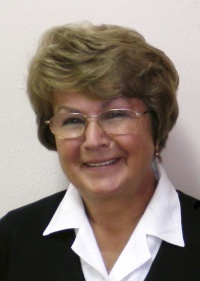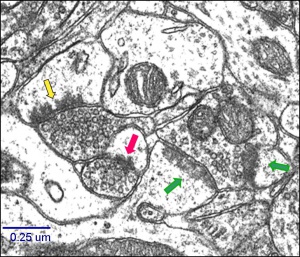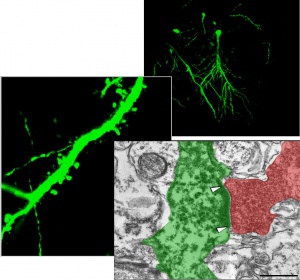Department of Cytology
Yaro (Обговорення • внесок) (smth to begin with) |
Yaro (Обговорення • внесок) (english translation correction) |
||
| Рядок 1: | Рядок 1: | ||
| − | [[File:skibo.jpg|200px|thumb|G.G. Skibo|left]] Department of Cytology was organized in 1996 on the basis of laboratory neurocytology. | + | [[File:skibo.jpg|200px|thumb|G.G. Skibo|left]] Department of Cytology was organized in 1996 on the basis of the laboratory of neurocytology. The head of department and the head of the research team is MD, professor, Bogomolets' prizewinner, Honored Worker of Ukraine Science Galina G. Skibo. |
== Science == | == Science == | ||
| − | Science Department of Cytology aims to study the molecular and cellular mechanisms of nervous tissue damage arising from the development of neurodegenerative diseases (cerebral ischemia, Alzheimer's disease, Parkinson's disease) or accompanying pathological states (perinatal pathology of the central nervous system, brain injury, stress, exocrine pancreatic failure), and study approaches to the prevention and correction of neurodegenerative processes. An important part of research is testing pharmacological agents to identify their neuroprotective properties. | + | Science Department of Cytology aims to study the molecular and cellular mechanisms of nervous tissue damage arising from the development of neurodegenerative diseases (cerebral ischemia, Alzheimer's disease, Parkinson's disease) or accompanying pathological states (perinatal pathology of the central nervous system, brain injury, stress, exocrine pancreatic failure), and study approaches to the prevention and correction of neurodegenerative processes. An important part of research is testing pharmacological agents to identify their neuroprotective properties. Studying the possibilities of using embryonic nervous tissue and stem cells to correct neurodegenerative processes caused by cerebral ischemia also has been started. |
| − | [[File:Synapsys.jpg|300px|thumb|Types of synapses red arrow - simple, yellow - perforated, green - multiple]] Scientists department found that short-term cerebral ischemia in model systems (in vitro and in vivo) causes the development of destructive changes of neurons and synaptic reorganization of staff in CA1 area of the hippocampus - a brain structure that is responsible for the processes of memory formation and learning and is highly sensitive to lack of oxygen and glucose. | + | [[File:Synapsys.jpg|300px|thumb|Types of synapses red arrow - simple, yellow - perforated, green - multiple]] Scientists of the department found that short-term cerebral ischemia in model systems (in vitro and in vivo) causes the development of destructive changes of neurons and synaptic reorganization of staff in CA1 area of the hippocampus - a brain structure that is responsible for the processes of memory formation and learning and is highly sensitive to lack of oxygen and glucose. With light and electron microscopy were investigated structural characteristics of delayed neuronal death of hippocampal CA1 area in ischemic effects of varying duration and period of reperfusion. Established in early periods of ischemic damage occurs synaptic remodeling apparatus, namely changing the spatial distribution of synaptic vesicles at presynaptic terminals, increasing the thickness and density of postsynaptic podovzhenist, changing the ratio of types of synaptic terminals upwards and multiple perforated significantly increased volume astroglial processes and their contact area of pre- and postsynaptic elements synapses. These data suggest that ischemic effect induces synaptic plastic adjustment device, and a clear correlation between changes in structural elements confirms the concept of "tripartite synapse", according to which astroglial processes that envelop the synapse, the third functional component with presynaptic bud and postsynaptic terminal. |
It was discovered structural and functional connection between the manifestations of destructive changes of neurons and glial reactivity level cells (microglia hyperplasia and hypertrophy of astrocytes) in ischemic hippocampal impact. | It was discovered structural and functional connection between the manifestations of destructive changes of neurons and glial reactivity level cells (microglia hyperplasia and hypertrophy of astrocytes) in ischemic hippocampal impact. | ||
| − | [[File:Hippocamp.jpg|250px|thumb|Three-dimensional reconstruction to study synaptic plasticity of hippocampal neurons and glial response to ischemic lesions|left]] In the model of cultured hippocampal slices was shown that a shortage of oxygen and glucose pyramidal neurons of the hippocampus CA1 area are the most vulnerable. Intercalary, | + | [[File:Hippocamp.jpg|250px|thumb|Three-dimensional reconstruction to study synaptic plasticity of hippocampal neurons and glial response to ischemic lesions|left]] In the model of cultured hippocampal slices was shown that a shortage of oxygen and glucose pyramidal neurons of the hippocampus CA1 area are the most vulnerable. Intercalary, astroglial and microglial cells compared were more resistant to oxygen-glucose derivation (SRM), moreover, their activation is observed, indicating the potential for interneurons and glia modulate pyramidal neurons function and affect the functioning of the system. Shows the change in the level of expression of subunits HIF-1α, HIF-3α, SERCA2b and PMCA1-2 in neurons and CA1 hippocampal area SA3 in response to holding SRM and anoxic preconditioning and reduce the number of damaged cells in both areas of the hippocampus with a stabilization of HIF-1. |
| − | It developed an original computer program image analysis using simulation in which cerebral ischemia in vivo and in vitro was investigated synaptic changes in the spatial distribution of vesicles in the terminal area CA1 of the hippocampus. It is shown that after an ischemic episode spatial cluster formed vesicles become more diffuse, and most organelles were removed from the active zone | + | It developed an original computer program image analysis using simulation in which cerebral ischemia in vivo and in vitro was investigated synaptic changes in the spatial distribution of vesicles in the terminal area CA1 of the hippocampus. It is shown that after an ischemic episode spatial cluster formed vesicles become more diffuse, and most organelles were removed from the active synapse zone. |
| − | In the study of correction of ischemic brain damage data were obtained regarding the neuroprotective action of aromatic amino acids, FGL - peptide mimetics NCAM, bioflavonoids, including Corvitin. In terms of experimental cerebral ischemia was found neuroprotective effect of hypoxic pre- and | + | In the study of correction of ischemic brain damage data were obtained regarding the neuroprotective action of aromatic amino acids, FGL - peptide mimetics NCAM, bioflavonoids, including Corvitin. In terms of experimental cerebral ischemia was found neuroprotective effect of hypoxic pre- and postconditioning the state CA1 area of the hippocampus. |
| − | + | The dependency of morphological and functional state of neurons of the hippocampus of exocrine pancreatic function and the data on the possibility of correcting pancreatic encephalopathy using enzyme replacement therapy were found. | |
| − | [[File:Stemcell.jpg|300px|thumb|The integration of stem cells in the nervous tissue in ischemic damage]] In model systems in vivo and in vitro study was conducted regenerative potential of stem cells of different origins in ischemic lesions. It is shown that stem cells transplanted after experimental ischemic impact in both models are able to survive in the long term the recipient tissue, differentiate into mature neurons as well as in cells | + | [[File:Stemcell.jpg|300px|thumb|The integration of stem cells in the nervous tissue in ischemic damage]] In model systems in vivo and in vitro study was conducted regenerative potential of stem cells of different origins in ischemic lesions. It is shown that stem cells transplanted after experimental ischemic impact in both models are able to survive in the long term the recipient tissue, differentiate into mature neurons as well as in astroglial cells, and integrate into the tissue of the recipient. It was established that stereotactic transplantation neural progenitor cells promotes restoration of spatial memory in animals after ischemic brain damage. |
| − | + | On clinic patients with ischemic stroke frequency of allelic polymorphism were studied genes encoding subunits of constitutional and imunoproteasom. When ischemic stroke in vivo had been replayed three types of proteolytic activity of the proteasome were measured (trypsin-, chymotrypsin-like and peptide-glutamil peptide-hydrolase) in the brain tissue of rats. These data suggest proteasome dysfunction in conditions of ischemic stroke. | |
== Team == | == Team == | ||
| Рядок 38: | Рядок 38: | ||
# Maleyeva G. | # Maleyeva G. | ||
| − | + | A scientific base for students (undergraduate and masters) of the University Centre "Institute of Biology" of Taras Shevchenko National University of Kyiv, the Kyiv branch of MIPT and Kyiv-Mohyla Academy is organized at the department. | |
== Research activities == | == Research activities == | ||
=== Main areas of research === | === Main areas of research === | ||
| − | * | + | * the viability and resistance hippocampal cells in modeling neuropathology of various origins (ischemia, stress, Alzheimer's disease) and search tools neuroprotection |
| − | * | + | * pathophysiological mechanisms perinatal pathology of the central nervous system of different origins and opportunities of the therapeutic modulation |
| − | * | + | * the cellular mechanisms of neurodegeneration in the early stages of rotenone Parkinson's disease model |
| − | * | + | * the dependence of structural and functional features of the brain from the gastrointestinal tract |
| − | * | + | * the features of regenerative stem cells in experimentally induced neurodegenerative pathologies of the brain (ischemia, brain injury) |
=== Research objects === | === Research objects === | ||
* Animals (rats, mice, gerbils, pigs) | * Animals (rats, mice, gerbils, pigs) | ||
| − | * Cell culture ( | + | * Cell culture (organ-like and dissociated culture) |
=== Research Methods === | === Research Methods === | ||
* Modeling neurodegenerative conditions in vivo (cerebral ischemia, Parkinson's disease, perinatal pathology of the central nervous system, brain injury, exocrine pancreatic insufficiency) and in vitro (cerebral ischemia, Alzheimer's disease, stress); | * Modeling neurodegenerative conditions in vivo (cerebral ischemia, Parkinson's disease, perinatal pathology of the central nervous system, brain injury, exocrine pancreatic insufficiency) and in vitro (cerebral ischemia, Alzheimer's disease, stress); | ||
* Microscopy: light, confocal, electron, | * Microscopy: light, confocal, electron, | ||
| − | * | + | * Immunohystochemistry methods, |
* Reverse transcription and polymerase chain reaction (single-cell RT-PCR), | * Reverse transcription and polymerase chain reaction (single-cell RT-PCR), | ||
| − | * | + | * Immuno blotting, |
* Quantitative ultrastructural analysis | * Quantitative ultrastructural analysis | ||
* Computerized image analysis, | * Computerized image analysis, | ||
Версія за 22:16, 19 грудня 2014
Department of Cytology was organized in 1996 on the basis of the laboratory of neurocytology. The head of department and the head of the research team is MD, professor, Bogomolets' prizewinner, Honored Worker of Ukraine Science Galina G. Skibo.Зміст |
Science
Science Department of Cytology aims to study the molecular and cellular mechanisms of nervous tissue damage arising from the development of neurodegenerative diseases (cerebral ischemia, Alzheimer's disease, Parkinson's disease) or accompanying pathological states (perinatal pathology of the central nervous system, brain injury, stress, exocrine pancreatic failure), and study approaches to the prevention and correction of neurodegenerative processes. An important part of research is testing pharmacological agents to identify their neuroprotective properties. Studying the possibilities of using embryonic nervous tissue and stem cells to correct neurodegenerative processes caused by cerebral ischemia also has been started.
Scientists of the department found that short-term cerebral ischemia in model systems (in vitro and in vivo) causes the development of destructive changes of neurons and synaptic reorganization of staff in CA1 area of the hippocampus - a brain structure that is responsible for the processes of memory formation and learning and is highly sensitive to lack of oxygen and glucose. With light and electron microscopy were investigated structural characteristics of delayed neuronal death of hippocampal CA1 area in ischemic effects of varying duration and period of reperfusion. Established in early periods of ischemic damage occurs synaptic remodeling apparatus, namely changing the spatial distribution of synaptic vesicles at presynaptic terminals, increasing the thickness and density of postsynaptic podovzhenist, changing the ratio of types of synaptic terminals upwards and multiple perforated significantly increased volume astroglial processes and their contact area of pre- and postsynaptic elements synapses. These data suggest that ischemic effect induces synaptic plastic adjustment device, and a clear correlation between changes in structural elements confirms the concept of "tripartite synapse", according to which astroglial processes that envelop the synapse, the third functional component with presynaptic bud and postsynaptic terminal.It was discovered structural and functional connection between the manifestations of destructive changes of neurons and glial reactivity level cells (microglia hyperplasia and hypertrophy of astrocytes) in ischemic hippocampal impact.
It developed an original computer program image analysis using simulation in which cerebral ischemia in vivo and in vitro was investigated synaptic changes in the spatial distribution of vesicles in the terminal area CA1 of the hippocampus. It is shown that after an ischemic episode spatial cluster formed vesicles become more diffuse, and most organelles were removed from the active synapse zone. In the study of correction of ischemic brain damage data were obtained regarding the neuroprotective action of aromatic amino acids, FGL - peptide mimetics NCAM, bioflavonoids, including Corvitin. In terms of experimental cerebral ischemia was found neuroprotective effect of hypoxic pre- and postconditioning the state CA1 area of the hippocampus. The dependency of morphological and functional state of neurons of the hippocampus of exocrine pancreatic function and the data on the possibility of correcting pancreatic encephalopathy using enzyme replacement therapy were found.
In model systems in vivo and in vitro study was conducted regenerative potential of stem cells of different origins in ischemic lesions. It is shown that stem cells transplanted after experimental ischemic impact in both models are able to survive in the long term the recipient tissue, differentiate into mature neurons as well as in astroglial cells, and integrate into the tissue of the recipient. It was established that stereotactic transplantation neural progenitor cells promotes restoration of spatial memory in animals after ischemic brain damage.On clinic patients with ischemic stroke frequency of allelic polymorphism were studied genes encoding subunits of constitutional and imunoproteasom. When ischemic stroke in vivo had been replayed three types of proteolytic activity of the proteasome were measured (trypsin-, chymotrypsin-like and peptide-glutamil peptide-hydrolase) in the brain tissue of rats. These data suggest proteasome dysfunction in conditions of ischemic stroke.
Team
Stuff
- Skibo G.G. - Head of Department, MD, Prof.
- Kovalenko T.M. – PhD, Leading Researcher
- Pivneva T.A. – PhD, Leading Researcher
- Nikonenko A.G. – PhD, Leading Researcher
- Tsupykov O.M – PhD, Leading Researcher
- Voitenko L.P. – PhD, Leading Researcher
- Lushnikova I.V. – PhD, Senior Researcher
- Osadchenko I.O. – PhD, Senior Researcher
- Patseva М.А. – PhD, Researcher
- Maistrenko A.M. – Junior Researcher
- Nikandrova E.O. – Junior Researcher
- Rybachuk O.A. – Junior Researcher
- Savchuk O.I. – Junior Researcher
- Smozhanyk K.G. – Lead Engineer
- Mayorenko P.P. – Lead Engineer
- Melnychuk L.P. - Senior Laboratory
Graduate students
- Goncharova K.
- Zabenko E.
- Maleyeva G.
A scientific base for students (undergraduate and masters) of the University Centre "Institute of Biology" of Taras Shevchenko National University of Kyiv, the Kyiv branch of MIPT and Kyiv-Mohyla Academy is organized at the department.
Research activities
Main areas of research
- the viability and resistance hippocampal cells in modeling neuropathology of various origins (ischemia, stress, Alzheimer's disease) and search tools neuroprotection
- pathophysiological mechanisms perinatal pathology of the central nervous system of different origins and opportunities of the therapeutic modulation
- the cellular mechanisms of neurodegeneration in the early stages of rotenone Parkinson's disease model
- the dependence of structural and functional features of the brain from the gastrointestinal tract
- the features of regenerative stem cells in experimentally induced neurodegenerative pathologies of the brain (ischemia, brain injury)
Research objects
- Animals (rats, mice, gerbils, pigs)
- Cell culture (organ-like and dissociated culture)
Research Methods
- Modeling neurodegenerative conditions in vivo (cerebral ischemia, Parkinson's disease, perinatal pathology of the central nervous system, brain injury, exocrine pancreatic insufficiency) and in vitro (cerebral ischemia, Alzheimer's disease, stress);
- Microscopy: light, confocal, electron,
- Immunohystochemistry methods,
- Reverse transcription and polymerase chain reaction (single-cell RT-PCR),
- Immuno blotting,
- Quantitative ultrastructural analysis
- Computerized image analysis,
- Morphometry.
List of laboratories with which there is scientific cooperation
- Department of Cell Biology and body Lund University, Sweden
- Institute of Neurobiology of the Slovak Academy of Sciences, Kosice, Slovakia
- Institute of brain dynamics National Institute for Health and Medical Research (INSERM), Marseille, France
- Max Delbruk Center for Molecular Medicine, Neuroscience Group, Berlin-Buch, Germany
Scientific advances. Selected publications for years 2011-2014
- Tsupykov O, Kyryk V, Smozhanik E, Rybachuk O, Butenko G, Pivneva T, Skibo G. Long-term fate of grafted hippocampal neural progenitor cells following ischemic injury. J Neurosci Res. 2014 Apr 22.
- Rybachuk O. A., Kyryk V. M, Poberezhnyi P. A., Butenko G. M., Skibo G. G., Pivneva T. A. Effect of bone marrow multipotent mesenchymal stromal cells on the neural tissue after ischemic injury in vitro, Cell and organ transplantology, - 2014, 2, № 1, p. 96-100.
- Pierzynowski S, Ushakova G, Kovalenko T, Osadchenko I, Goncharova K, Gustavsson P, Prykhodko O, Wolinski J, Slupecka M, Ochniewicz P, Weström B, Skibo G. Impact of colostrum and plasma immunoglobulin intake on hippocampus structure during early postnatal development in pigs. Int J Dev Neurosci. 2014 Mar 15. pii: S0736-5748(14)00037-9.
- Nikonenko I, Nikonenko A, Mendez P, Michurina TV, Enikolopov G, Muller D. Nitric oxide mediates local activity-dependent excitatory synapse development. Proc Natl Acad Sci U S A. 2013, 110(44):E4142-4151.
- Rybachuk О. А, Levin R. E., Кyryk V. М., Susarova D. K., Tsupykov О. M., Smozhanik E. G., Butenko G. M., Skibo G. G., Troshin P. A., Pivneva Т. А. Effect of a water soluble derivative of fullerene C60 on the features neural progenitor cells in vitro, Cell and organ transplantology, 2013, 1, № 1, 96-107
- Никоненко А.Г. Введение в количественную гистологию. Киев: Книга плюс, 2013, 256с. 500 прим. 15,5 друк. арк.
- Tress O, Maglione M, May D, Pivneva T, Richter N, Seyfarth J, Binder S, Zlomuzica A, Seifert G, Theis M, Dere E, Kettenmann H, Willecke K. Panglial gap junctional communication is essential for maintenance of myelin in the CNS. J. Neurosci. 2012. 32(22). P.7499-518.
- Pierzynowski S, Swieboda P, Filip R, Szwiec K, Valverde Piedra JL, Gruijc D, Prykhodko O, Fedkiv O, Kruszewska D, Botermans J, Svendsen J, Skibo G, Kovalenko T, Osadchenko I, Goncharova K, Ushakova G, Weström B. Behavioral changes in response to feeding pancreatic-like enzymes to exocrine pancreatic insufficiency pigs. J Anim Sci. 2012 Dec;90 Suppl 4:439-41.
- Woliński J, Słupecka M, Weström B, Prykhodko O, Ochniewicz P, Arciszewski M, Ekblad E, Szwiec K, Ushakova, Skibo G, Kovalenko T, Osadchenko I, Goncharova K, Botermans J, Pierzynowski S. Effect of feeding colostrum versus exogenous immunoglobulin G on gastrointestinal structure and enteric nervous system in newborn pigs. J Anim Sci. 2012 Dec;90 Suppl 4:327-30.
- Pierzynowski S, Szwiec K, Valverde Piedra JL, Gruijc D, Szymanczyk S, Swieboda P, Prykhodko O, Fedkiv O, Kruszewska D, Filip R, Botermans J, Svendsen J, Ushakova G, Kovalenko T, Osadchenko I, Goncharova K, Skibo G, Weström B. Exogenous pancreatic-like enzymes are recovered in the gut and improve growth of exocrine pancreatic insufficient pigs. J Anim Sci. 2012 Dec;90 Suppl 4:324-6.
- Kopach O, Kruglikov I, Pivneva T, Voitenko N, Verkhratsky A, Fedirko N. Mitochondria adjust Ca(2+) signaling regime to a pattern of stimulation in salivary acinar cells. Biochim Biophys Acta. 2011 Oct;1813(10):1740-8.
- Puchkov D, Leshchyns'ka I, Nikonenko AG, Schachner M, Sytnyk V. NCAM/spectrin complex disassembly results in PSD perforation and postsynaptic endocytic zone formation. Cereb Cortex. 2011 Oct;21(10):2217-32.
- Tsupykov O.M., Poddubnaya A.O., Smozhanyk K.G., Kyryk V.M., Kuchuk O.V., Butenko G.M., Semenova E.A., Pivneva T.A., Skibo G.G. Integration of grafted neural progenitor cells in host hippocampal circuitry after ischemic injury// Neurophysiology. – 2011. – V.43., №.4., P. 372-375.
- Lushnikova I, Skibo G, Muller D, Nikonenko I. Excitatory synaptic activity is associated with a rapid structural plasticity of inhibitory synapses on hippocampal CA1 pyramidal cells. Neuropharmacology. 2011 Apr;60(5):757-64.
- Lushnikova I, Orlovsky M, Dosenko V, Maistrenko A, Skibo G. Brief anoxia preconditioning and HIF prolyl-hydroxylase inhibition enhances neuronal resistance in organotypic hippocampal slices on model of ischemic damage. Brain Res. 2011 Apr 22;1386:175-83.



